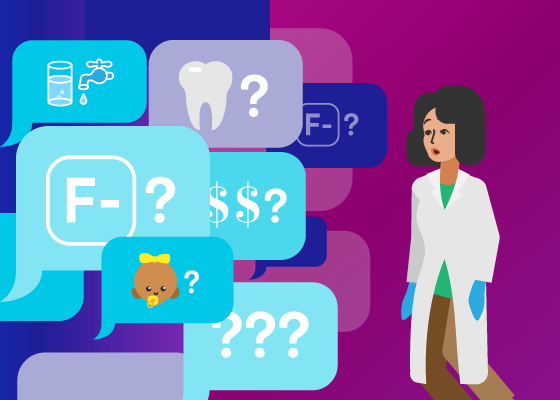Managing caries and motivating change, part 2: Motivational interviewing
How do you motivate your patients? Discover how caries risk assessments and motivational interviewing tactics can help you connect with…


How fluent are you in fluoride? Learn how to talk about the benefits of fluoride with patients and staff – to ensure patient acceptance and healthier smiles.
Over the past several years, fluoride has grown into a conspicuous and controversial topic for patients and clinicians alike. For patients, the mineral is confusing, suspicious and easy to label as “toxic,” or “not for me.” For dental professionals, trying to communicate the benefits of fluoride much less recommend fluoride-based treatments has become a minefield littered with misinformation that’s not always easy to navigate.
While fluoride skepticism is nothing new, many patients are missing out on beneficial treatments because of how fluoride is discussed in the dental office. However, with a little collaboration, teamwork and creative thinking, you can not only provide patients with the best care possible, but also improve the way your team handles the topic of fluoride – and reinforce your recommendations at every patient touchpoint.
Talking to patients isn’t always simple, particularly with a touchy, emotional subject like fluoride. But there’s a lot of confusing scientific jargon and convincing misinformation out there and it’s up to you and your team to help debunk the myths and reframe the conversation.
If your patient expresses concerns or has questions about fluoride, the first and most important thing to do is listen. While it can be easy to brush off concerns because of your own background, taking the time to acknowledge and understand your patient’s point of view can help lay the groundwork for a productive conversation rather than a debate. From there, asking what exactly they’ve heard and from what source can help guide you to the proper response.
Many patients are suspicious of fluoride because it sounds like a chemical, which can have negative connotations. While it may seem basic to a dental professional, addressing these misconceptions immediately can help patients see fluoride for what it actually is: a naturally occurring, beneficial mineral.
Should a patient ask about fluoride, here are some basic facts to cover:
Some of the main concerns patients have about fluoride are around toxicity. These are completely valid concerns. The reality is that while fluoride at low levels is proven to promote healthy teeth, it’s also true that high concentrations of fluoride can be dangerous.4 Rather than gloss over the facts, recognizing what too much fluoride can do – and how much is too much – can go a long way in improving patient acceptance and trust.
Too much fluoride can cause dental fluorosis (streaks or spots on teeth that are purely cosmetic), or skeletal fluorosis (a very rare bone disease).4,6,7,8 However, the amount of fluoride one would have to consume for either of these outcomes is extreme, such as eating entire tubes of toothpaste or drinking multiple gallons of water daily.6,8 When it comes to the fluoride added to water and how much is recommended for brushing teeth or used in clinical treatments, it’s all carefully measured to specific levels that prevent tooth decay (all of which are well below risk level). You can help patients think of it like the dosages on their medication or adding salt to a meal. You wouldn’t down an entire bottle of aspirin or dump a whole salt shaker over your dinner and expect no ill effects afterward – but use the right amount and you’ll see the benefits.
The topic of fluoride and children is an interesting one, because the conversation can go multiple ways. Some people believe fluoride is only for children, while others may be hesitant to introduce it to their kids. For patients who believe it’s only for kids, changing their attitude may be as simple as asking why they come to the dentist or brush their teeth. The fact of the matter is that adults’ teeth are vulnerable to decay too – and fluoride could help reduce risk.
Fluoride is also very beneficial for children. A child’s teeth are still developing and tend to be “softer” or less mineralized than adult teeth. Fluoride is the substance that helps teeth become hard and more resistant to decay, but because their enamel is still developing, they’re more susceptible to dental fluorosis.8 It’s important to remember that fluorosis occurs only if fluoride is used above recommended levels. If parents raise concerns, it’s important to let them know that fluoride dosage recommendations are age-specific and there are options to limit exposure. These include monitoring brushing, using the recommended amount of toothpaste and assuring that water used in the home is at the optimal fluoride level, especially for homes that utilize well water rather than municipal water supplies.8
Unfortunately, there’s one more hurdle many clinicians have to face when it comes to recommending fluoride treatments – insurance. The sad truth is that many adult patients will refuse fluoride treatments, or any dental procedure for that matter, because of cost and lack of insurance coverage.
Fluoride treatments generally aren’t covered for adults, which makes it easy for patients to write them off as unnecessary or “just for kids.” So how do you convince patients to accept treatments outside of their coverage? One way is to reframe dental insurance.
Despite the fact that oral health is a critical part of a patient’s overall health, dental insurance isn’t like health insurance – it’s more like homeowners’ insurance. The upkeep you do on your home isn’t always covered by your insurance, but you still make those updates and repairs to avoid big charges down the line. Similarly, when you pay out-of-pocket for a fluoride treatment, you’re investing in the upkeep of your oral health and avoiding the much higher cost of more invasive treatment later.
In an ideal world, money wouldn’t stand in the way of providing the best care for your patients. Until then, recognizing the reality of insurance and reframing preventative treatments could help patients invest in the benefits of fluoride.
While the above information can help you start the fluoride conversation, it’s important to remember that every patient has different needs. Some will respond to facts, studies and numbers; some to emotional anecdotes; some may take multiple visits to convince; and some simply won’t take your recommendations. But if you approach each appointment as a conversation founded on evidence-based information and respect, you’ll bring yourself that much closer to changing minds – and improving smiles.
Often, preventative care is placed solely on the hygienist’s shoulders, but for a practice to take full advantage of the benefits of fluoride, everyone needs to understand what it can do and why it’s recommended. This means the fluoride conversation has to start within your practice. This could mean attending educational events or inviting speakers to your practice, but should result in a strong, collaborative prevention program built on the expertise of every member of the team.
From the front desk to the dentist’s chair, maintaining a mutually supportive, streamlined dialogue about fluoride between all staff members not only creates a strong community atmosphere, but helps to reinforce your recommendations at every touchpoint and ultimately provide the best care possible.
Fluoride has become increasingly conspicuous in the social consciousness. Whether this is good or bad comes down to how prepared you and your team are to deal with it. By taking the time to educate yourself, your staff and your patients on the benefits of fluoride and changing the way you approach the topic, you’re laying the groundwork for a streamlined practice, more patient acceptance, and healthier, stronger smiles.
Sources

How do you motivate your patients? Discover how caries risk assessments and motivational interviewing tactics can help you connect with…

Caries is a complicated multifactorial disease. In this two-part series, explore how caries risk assessments can help improve evaluation and…

Zirconia may be part of your everyday vocabulary, but how much do you know about this ceramic material? Learn more…